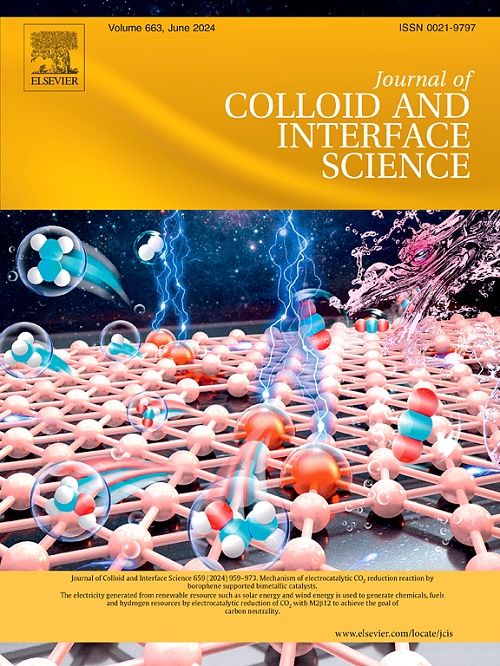氧空位诱导NiCo2O4/NiSe2异质结构电催化剂的高效析氧反应
IF 9.4
1区 化学
Q1 CHEMISTRY, PHYSICAL
引用次数: 0
摘要
尖晶石型过渡金属氧化物(AB2O4)是一种很有前途的非贵金属析氧催化剂,解决了电催化水分解中成本高、稳定性差的难题。然而,它们的广泛应用受到低导电性和次优性能的阻碍。在这项研究中,我们开发了一种氧空位锚定策略,在泡沫镍衬底上构建了一种高效耐用的NiCo2O4-NiSe2异质结催化剂。三维交联多孔纳米棒阵列有利于质量和电荷的传输。理论模拟证实,丰富的互联界面增强了OH中间体的电子传递动力学和吸附。因此,合成的NiCo2O4@NiSe2/NF在电流密度为60 mA cm - 2时的过电位仅为299 mV,显著优于单相NiCo2O4,并表现出优异的耐用性。本文章由计算机程序翻译,如有差异,请以英文原文为准。

Oxygen vacancy induced construction of NiCo2O4/NiSe2 heterostructure electrocatalyst for high-efficiency oxygen evolution reaction
Spinel-type transition metal oxide (AB2O4) are promising non-precious metal catalysts for oxygen evolution reaction (OER), addressing the challenges of high cost and poor stability in electrocatalytic water splitting. However, their widespread application is hindered by low electrical conductivity and suboptimal performance. In this study, we developed an oxygen vacancy anchoring strategy to construct a highly efficient and durable NiCo2O4-NiSe2 heterojunction catalyst on a nickel foam substrate. The three-dimensional cross-linked porous nanorod array facilitates mass and charge transportation. The abundant interconnected interfaces enhance electron transfer kinetics and adsorption of OH intermediates, as confirmed by theoretical simulations. As a result, the as-synthesized NiCo2O4@NiSe2/NF exhibits an overpotential of only 299 mV at a current density of 60 mA cm−2, significantly outperforming the single-phase NiCo2O4 and demonstrating exceptional durability.
求助全文
通过发布文献求助,成功后即可免费获取论文全文。
去求助
来源期刊
CiteScore
16.10
自引率
7.10%
发文量
2568
审稿时长
2 months
期刊介绍:
The Journal of Colloid and Interface Science publishes original research findings on the fundamental principles of colloid and interface science, as well as innovative applications in various fields. The criteria for publication include impact, quality, novelty, and originality.
Emphasis:
The journal emphasizes fundamental scientific innovation within the following categories:
A.Colloidal Materials and Nanomaterials
B.Soft Colloidal and Self-Assembly Systems
C.Adsorption, Catalysis, and Electrochemistry
D.Interfacial Processes, Capillarity, and Wetting
E.Biomaterials and Nanomedicine
F.Energy Conversion and Storage, and Environmental Technologies

 求助内容:
求助内容: 应助结果提醒方式:
应助结果提醒方式:


